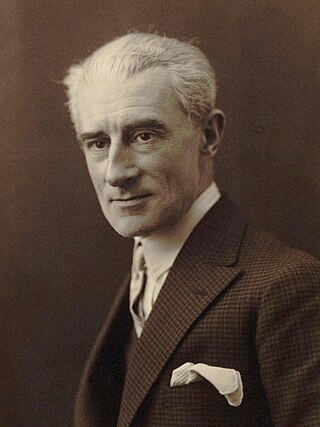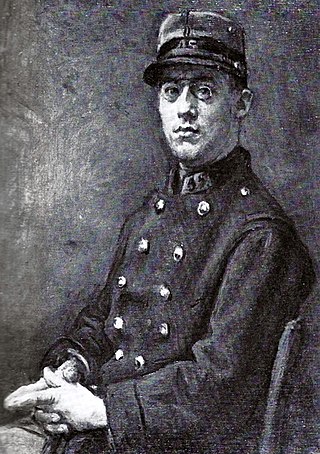Related Research Articles

(Achille) Claude Debussy was a French composer. He is sometimes seen as the first Impressionist composer, although he vigorously rejected the term. He was among the most influential composers of the late 19th and early 20th centuries.

Joseph Maurice Ravel was a French composer, pianist and conductor. He is often associated with Impressionism along with his elder contemporary Claude Debussy, although both composers rejected the term. In the 1920s and 1930s Ravel was internationally regarded as France's greatest living composer.

Alexis-Emmanuel Chabrier was a French Romantic composer and pianist. His bourgeois family did not approve of a musical career for him, and he studied law in Paris and then worked as a civil servant until the age of thirty-nine while immersing himself in the modernist artistic life of the French capital and composing in his spare time. From 1880 until his final illness he was a full-time composer.

Paul Antonin Vidal was a French composer, conductor and music teacher mainly active in Paris.

La valse, poème chorégraphique pour orchestre, is a work written by Maurice Ravel between February 1919 and 1920; it was first performed on 12 December 1920 in Paris. It was conceived as a ballet but is now more often heard as a concert work.
La Sulamite is a scène lyrique by Emmanuel Chabrier to words by Jean Richepin for solo voice, women's chorus and orchestra. The text of La Sulamite is based on extracts from The Song of Songs.

"Bourrée fantasque" is a piece of music for solo piano by Emmanuel Chabrier (1841–1894), being one of his last major completed works.
España, rhapsody for orchestra is the most famous orchestral composition by French composer Emmanuel Chabrier (1841–1894). Written in 1883 after a trip to Spain, it was dedicated to the conductor Charles Lamoureux, who conducted the first public performance on 4 November 1883, at the Théâtre du Château d’Eau for the Société des Nouveaux Concerts in Paris.
À la musique is a vocal work by Emmanuel Chabrier for solo soprano, women’s chorus and orchestra. The words are by poet and playwright Edmond Rostand.
Pièces pittoresques are a set of ten pieces for piano by Emmanuel Chabrier. Four of the set were later orchestrated by the composer to make his Suite pastorale.

Joyeuse marche is a popular orchestra piece by the French composer Emmanuel Chabrier. It is the second half of a pair of orchestral pieces first performed on 4 November 1888 in Angers, conducted by the composer. The Joyeuse marche is dedicated to Vincent d'Indy.
Souvenirs de Munich is a quadrille on themes from Wagner's Tristan and Isolde, for piano, four hands by Emmanuel Chabrier.

Vaucochard et fils Ier is an unfinished opérette by Emmanuel Chabrier of which only some numbers survive. The French libretto was by Paul Verlaine.

Alexandre Tharaud is a French pianist. He is active on the concert stage and has released a large and diverse discography.

The Sarabandes are three dances for solo piano composed in 1887 by Erik Satie. Along with the famous Gymnopédies (1888) they are regarded as his first important works, and the ones upon which his reputation as a harmonic innovator and precursor of modern French music, beginning with Debussy, principally rests. The Sarabandes also played a key role in Satie's belated "discovery" by his country's musical establishment in the 1910s, setting the stage for his international notoriety.
Roger Delage was a French musicologist and conductor. He was the leading authority on the life and works of the composer Emmanuel Chabrier, and as a conductor was known for reviving the music of early French composers such as Guillaume de Machaut.

The French composer Emmanuel Chabrier (1841–1894) wrote music in many genres, including opera and operetta, piano, orchestral music, and songs with piano accompaniment. The songs cover most of his creative years, from the early 1860s to 1890, when the illness which would kill him prevented much composition. He came late to music as a profession, but – although being an exceptional pianist – he had no trappings of a formal training: no conservatoire studies, no Prix de Rome, "none of the conventional badges of French academic musicians, by whom he was regarded as an amateur".

Croquis et agaceries d'un gros bonhomme en bois, translated as Sketches and Exasperations of a Big Wooden Dummy, is a 1913 piano composition by Erik Satie. One of his pre-World War I humoristic suites, it was published by E. Demets that same year. Ricardo Viñes gave the premiere during a concert of the Société Nationale de Musique at the Salle Pleyel in Paris on March 28, 1914. A typical performance lasts about five minutes.

Les trois valses distinguées du précieux dégoûté (The Three Distinguished Waltzes of a Jaded Dandy) is a 1914 piano composition by Erik Satie. The shortest of his humoristic keyboard suites of the 1910s, it features what author James Harding called "the most baroque verbal scaffolding Satie ever erected around his music". A performance lasts around 3 minutes.
References
- 1 2 3 4 Delage R. Emmanuel Chabrier. Fayard, Paris, 1999.
- 1 2 3 Myers R. Emmanuel Chabrier and his circle. J M Dent and Sons, London, 1973.
- ↑ 'J’ai fait la troisième valse' – I have done the third waltz
- ↑ Desaymard J. Emmanuel Chabrier d'après ses lettres. L'homme et l'oeuvre. Paris, Fernand Roches, 1934.
- ↑ Poulenc F. Emmanuel Chabrier. La Palatine, Geneva & Paris, 1961. A recording was made by Poulenc and Marcelle Meyer in Paris in 1955.